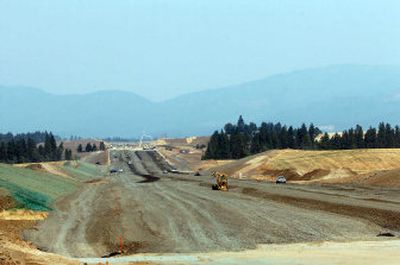Highway funds falling short of need

BOISE – Funds are coming up short for Idaho’s ambitious program to fix state highways – a program that includes two major upgrades to dangerous stretches of U.S. Highway 95 in North Idaho.
Cost estimates to complete the six highway projects around the state over a 10-year period have risen to $1.6 billion, but the bonds – the first round of which were just issued – are now projected to bring in only $998 million.
State transportation officials and Gov. Jim Risch’s chief of staff, John Sandy, broke the news to the Legislature’s joint budget committee at its interim meeting Thursday.
“We’re going to leave it up to the (transportation) board and the Legislature to do the right thing, and they will,” Sandy told the legislators.
Rep. Frank Henderson, R-Post Falls, a member of the joint committee, said he’s committed to completing both U.S. 95 projects.
“It isn’t just money we’re dealing with here – we’re dealing with lives,” he said. “That’s the challenge for the Legislature, is to find a way to complete these projects.”
Idaho has just sold its first $200 million in GARVEE bonds for the program. GARVEE stands for Grant Anticipation Revenue Vehicle, and is a special type of bonding created by Congress to allow states to borrow against their future federal highway allocations to pay for road projects now.
Bond officials took a conservative approach: Rather than assume Idaho’s federal highway funds will grow by 3.3 percent a year, they chose to “flat-line” the projection, Sandy said. That lower estimate, which assumes Idaho will get $251 million in federal highway funds every year through 2029, combined with caps and other limits the Legislature put on the overall bonding program, pushed the total bonding amount down to $998 million. It had been projected at $1.2 billion after the legislative limits, down from the original $1.6 billion then-Gov. Dirk Kempthorne originally had sought for the project.
At the same time, costs for construction materials and fuel – especially for asphalt, cement and steel – are soaring. That’s pushing up the costs of the road projects, which include major improvements to U.S. 95 from Worley to Setters and from Garwood to Sagle.
The state’s options include lifting some of the caps on the bonding, scaling back or eliminating projects, or adding other funding. The Idaho Transportation Board will meet next month to work on a recommendation, and Risch will forward it to the Legislature.
“Everybody’s really being open and trying to work through this thing,” Sandy said. “These numbers are fairly new.”
Senate Finance Chairman Dean Cameron, R-Rupert, said, “Hopefully there will be not necessarily any scaling back. There may be some adjustments.”
Both Sandy and lawmakers said the soaring construction costs – which have risen by around 30 percent – are proof that the state was right to go ahead with the GARVEE plan. It’s aimed at borrowing money to build 30 years worth of highway projects in just a decade, with the idea that interest costs will be more than offset by avoiding inflation. It’s also aimed at moving up safety-oriented road improvements.
The two U.S. 95 projects, Henderson said, “have to stay in the plan. It’s a matter of public safety. This isn’t convenience or aesthetic reasons – this is to save lives.”
Henderson noted that people die every year on busy U.S. 95, the state’s only north-south route and the main thoroughfare through North Idaho. “We know how the population has grown, the traffic,” he said. “We just have to improve the safety of those highways.”
The project from Worley to Setters includes a new four-lane, divided highway to replace narrow stretches and dangerous curves. The Garwood-to-Sagle project would replace much of the congested highway from Coeur d’Alene to Sandpoint with a new four-lane freeway.
Henderson said there are also other “critical transportation needs” that Idaho must address in North Idaho, including various traffic bottlenecks.